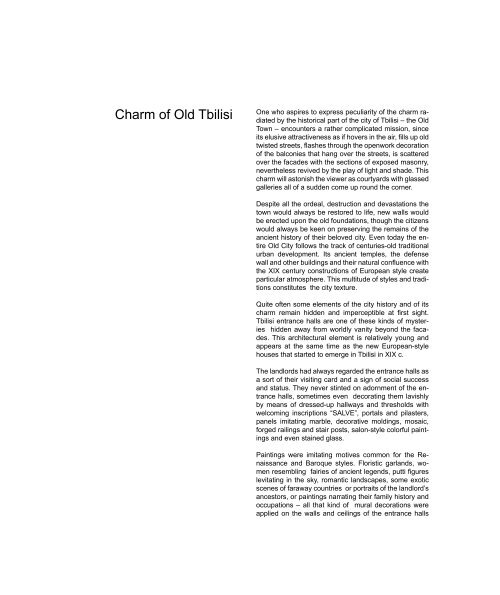Charm of Tbilisi Tbilisis xibli
Charm of Tbilisi Tbilisis xibli
Charm of Tbilisi Tbilisis xibli
You also want an ePaper? Increase the reach of your titles
YUMPU automatically turns print PDFs into web optimized ePapers that Google loves.
<strong>Charm</strong> <strong>of</strong> Old <strong>Tbilisi</strong><br />
One who aspires to express peculiarity <strong>of</strong> the charm radiated<br />
by the historical part <strong>of</strong> the city <strong>of</strong> <strong>Tbilisi</strong> – the Old<br />
Town – encounters a rather complicated mission, since<br />
its elusive attractiveness as if hovers in the air, fills up old<br />
twisted streets, flashes through the openwork decoration<br />
<strong>of</strong> the balconies that hang over the streets, is scattered<br />
over the facades with the sections <strong>of</strong> exposed masonry,<br />
nevertheless revived by the play <strong>of</strong> light and shade. This<br />
charm will astonish the viewer as courtyards with glassed<br />
galleries all <strong>of</strong> a sudden come up round the corner.<br />
Despite all the ordeal, destruction and devastations the<br />
town would always be restored to life, new walls would<br />
be erected upon the old foundations, though the citizens<br />
would always be keen on preserving the remains <strong>of</strong> the<br />
ancient history <strong>of</strong> their beloved city. Even today the entire<br />
Old City follows the track <strong>of</strong> centuries-old traditional<br />
urban development. Its ancient temples, the defense<br />
wall and other buildings and their natural confluence with<br />
the XIX century constructions <strong>of</strong> European style create<br />
particular atmosphere. This multitude <strong>of</strong> styles and traditions<br />
constitutes the city texture.<br />
Quite <strong>of</strong>ten some elements <strong>of</strong> the city history and <strong>of</strong> its<br />
charm remain hidden and imperceptible at first sight.<br />
<strong>Tbilisi</strong> entrance halls are one <strong>of</strong> these kinds <strong>of</strong> mysteries<br />
hidden away from worldly vanity beyond the facades.<br />
This architectural element is relatively young and<br />
ap pears at the same time as the new European-style<br />
houses that started to emerge in <strong>Tbilisi</strong> in XIX c.<br />
The landlords had always regarded the entrance halls as<br />
a sort <strong>of</strong> their visiting card and a sign <strong>of</strong> social succe ss<br />
and status. They never stinted on adornment <strong>of</strong> the entrance<br />
halls, sometimes even decorating them lavishly<br />
by means <strong>of</strong> dressed-up hallways and thresholds with<br />
welcoming inscriptions “SALVE”, portals and pilasters,<br />
panels imitating marble, decorative moldings, mosaic,<br />
forged railings and stair posts, salon-style colorful paintings<br />
and even stained glass.<br />
Paintings were imitating motives common for the Renaissance<br />
and Baroque styles. Floristic garlands, women<br />
resembling fairies <strong>of</strong> ancient legends, putti figu res<br />
levitating in the sky, romantic landscapes, some exo tic<br />
scenes <strong>of</strong> faraway countries or portraits <strong>of</strong> the la nd lord’s<br />
ancestors, or paintings narrating their family history and<br />
occupations – all that kind <strong>of</strong> mural decorations were<br />
applied on the walls and ceilings <strong>of</strong> the entrance halls



